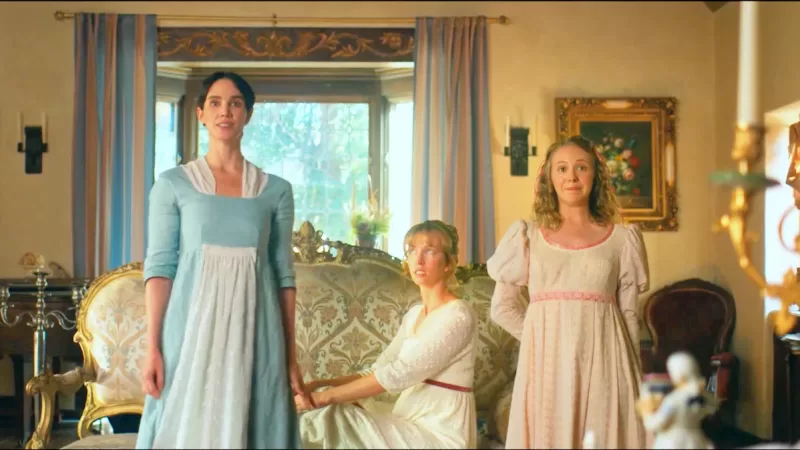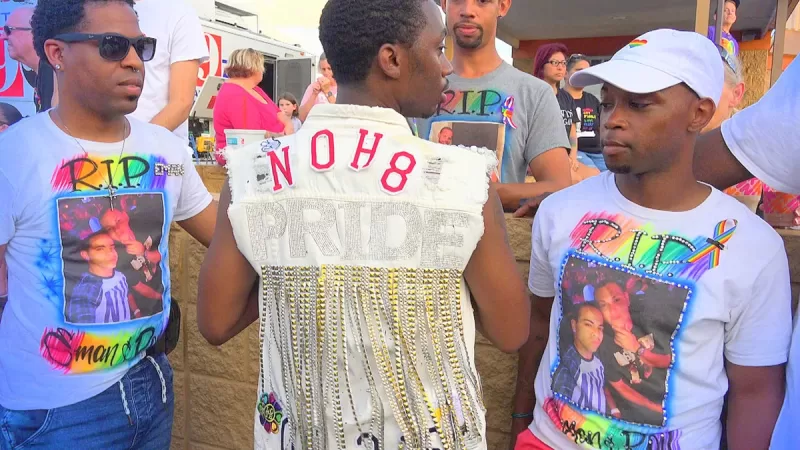How a first-time director without any connections got his first micro-budget film made and into theaters.
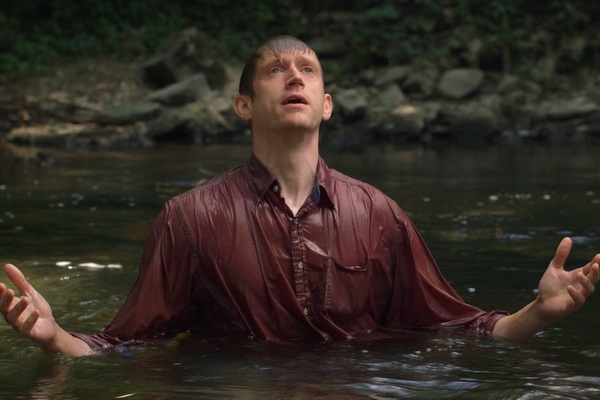
As It Is In Heaven” is a feature film directed by Joshua Overbay in Kentucky around a small college film department. Shot in Scope digital video, the film is opening in New York City, Chicago, Seattle, Lexington, L.A., New Orleans and other cities in July and August. Below, Overbay writes about how, as a first-time director, he managed to make a micro-budget film and get it released.
Like every other young, ambitious directing student, I graduated film school with two goals in mind: making a feature film and making it as soon as humanly possible. I had a solid script two years in the making, a business plan, a team of committed filmmakers, a “reasonably” low budget ($900,000), some industry connections and a degree of momentum from a year on the festival circuit. According to the textbooks, we were set for success. Even our script was built on the practical wisdom that we should suspend our desire to make personal films and instead focus on something that could start our careers: a successful genre film. And yet, after two years of numerous meetings, false starts, trips to Nashville and LA, phone calls, thousands of emails, multiple rewrites, and various “attachments” from cast and crew members, we hadn’t raised a dime.
Suddenly, my young idealism was challenged: Were the many sacrifices my wife made to get me through film school worthless? Had I put us into decades of debt for a ridiculous dream? “Many are called, but few are chosen.” Maybe I’m not “chosen.”
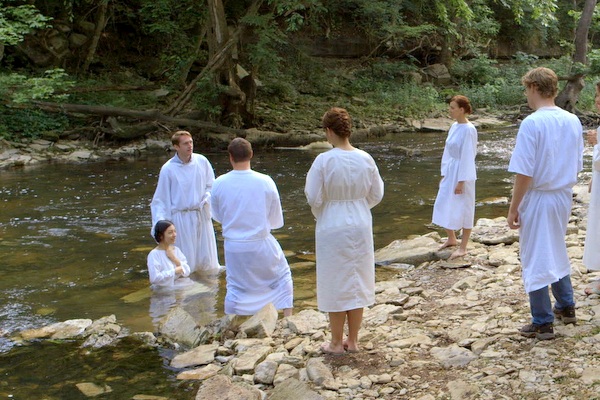
A baptism in the film AS IT IS IN HEAVEN, about a religious sect approaching the end of the world. Photo credit: IN HEAVEN MOVIE, LLC.
It all came to a head via a trip home for Thanksgiving. As I was driving, I turned to my wife and said, “It’s over. It’s not going to happen.” And as soon as I said it out loud, I knew it was true.
I don’t believe in fate. Nor do I believe in quitting, which is why it’s hard for me to accept defeat. After about an hour of sadness, I came up with a new plan: I would make a micro-budget film. Screw placing marketability above artistry. I would make something I care about.
At the time, I taught film at a university with a good library of equipment, so I knew I could get most of my gear for close to free. Sure, I would have to start over with a new team and a new script, but I would hit the restart button and commit to doing something personal and honest. This happened in November of 2011.
And now, almost three years later, that film is completed. “As It Is in Heaven” is showing in multiple locations across the U.S. this summer. In fact, it even got a glowing review from The Hollywood Reporter. So, how did we do it?
Production: Embark Visuals
Cast: Chris Nelson, Luke Beavers, John Lina, Abi Van Andel, Jin Park, Shannon Baker
Director: Joshua Overbay
Screenwriter: Ginny Lee Overbay
Producers: Michael Grout, Nathaniel Glass
Executive producers: Aaron Holmes, Isaac Pletcher, Joshua Overbay, Nathaniel Glass, Christopher Free
Director of photography: Isaac Pletcher
Editor: L.E. Nicolette
Production designer: Meg Barker
Composers: Ben Zoeller, Timothy Morton
Not rated, 86 min.
Below is a list of fifteen things we did to help us get our movie made. Certainly, there are many more, but I feel that these principles are absolutely essential to making a successful micro-budget film:
1. Get off your ass and make a movie.
Frustration and impatience are essential traits if you want to make a feature film with no money. Combine this frustration with an important realization: Unless your last name is “Coppola,” your short film received major attention at Sundance, or you have many rich uncles you’re not going to be make a feature film for more than $100,000. You’re going to have to work for it. And even after that work, it’s unrealistic for you to make something with a significant budget.
2. Stop worrying about writing something marketable.
Write something you deeply care about: Our first script was horror because marketability was essential to our business plan. Looking back, even if we had a Clooney-sized attachment, we still wouldn’t have raised a dime. No one knew us and we had no industry presence. And unless that’s different with you, you need to recalibrate your expectations. Make your nano-budget film personal. It should become the movie you’re willing to die for. For me, committing to making something incredibly private was what gave me the energy to endure the hardship to come.
3. Work with your close friends, especially the brutally honest ones.
I’m not exaggerating when I say that making your first feature will be the most stressful thing you’ve attempted. And the less money you have, the more difficult it will be. Work with people who will challenge you, who aren’t afraid to be candid, and who will push you to do better. Work with people you respect, not those who will simply be nice. In addition, work with people you deeply trust. What does trust look like in an artistic collaboration? It means that the commitment to the betterment of the work comes first. It also means that neither of you are concerned with subverting or undermining the other. The thing that binds you together is a shared trust in doing whatever it takes to make the best film possible. These collaborations are rare. Once you find one, hold onto it with all your strength.
4. Crowdfund for the first and last time of your life.
We raised the bulk of our budget from Kickstarter. To do this, we (the producers and I) repurposed our Twitter and Facebook accounts into a constant stream of updates, reminders, and personal pleas. Did I lose Facebook “friends” in the process? Yes. Did I lose Twitter followers? Yes. Do I care? No, because I financed my feature film. Social media provides a unique and simple opportunity for you to connect with all the people from your past and present. If you have a reputation for being a kind and considerate person you might be surprised by how many of your friends come to your aid. In addition, the entire crew got involved. So, instead of three or four dudes pushing it, we had fifteen or twenty. But just remember, crowdfunding is best if it’s one and done. Once you ask your friends for a favor, it’s much more difficult to get them to do it again.
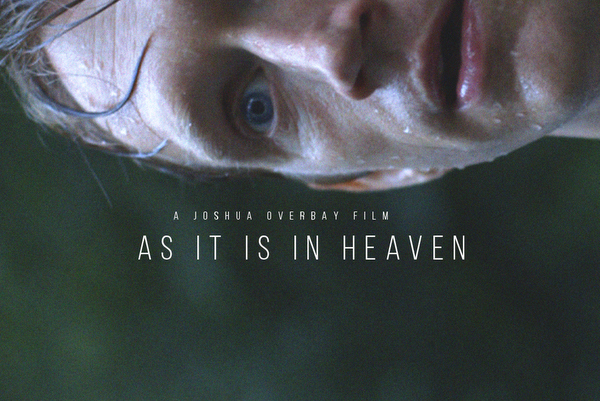
5. Budget for more than post-production. Budget for film festivals, travel, and theatrical runs.
Even though we raised all the money necessary to complete production, we failed to fully consider the costs of post-production. Do everything in your power to pay for a picture editor and a sound editor/mixer. Don’t do it yourself. The picture will suffer. And even if you can’t pay much, some goes a long way. It ensures their participation and gives you a bit of needed latitude in the contract formation process.
Also, make sure to budget for at least thirty festivals. While attending the Maine Media Workshops, I met Maureen Ryan, the producer of Man on a Wire and a professor at Columbia University. One thing she immediately advised was to think in festival tiers: upper (international), middle (national), and regional (lower). You want to make sure you have the money to apply to all three. If you put all of your money into the upper tier festivals, you risk getting into nothing. Middle and lower tier festivals can you help you get reviews, befriend programmers who will push your work via their social media platforms, meet the press, and get tips from other filmmakers.
Budget for travel and housing. Some festivals take care of this, but you never want to assume that. Otherwise, you will end up unable to attend your own screening, which renders the festival experience meaningless. You can’t expect to get reviews and garner buzz if you’re sitting at home. In addition, if you’re crazy-lucky enough to get your film in theaters, you need to attend as many screenings as possible. This summer we’re playing in Chicago, LA, NYC, and Seattle, but because we didn’t raise enough money, not all of us are able to attend.
6. Teach at a Film School.
Instead of moving to LA after I graduated, I decided to do something different: teach. Four years later, it’s clear that this was easily the best decision I could’ve made. Instead of moving my family to a high-priced city where we would struggle from paycheck to paycheck, I chose financial stability and security. Yes, many of my friends moved to LA. And no, none of them have made a feature film since graduating. Is this because they lack talent, resourcefulness, or strategic thinking? Absolutely not! Instead, their headspace is packed with the daily demand of financially surviving LA.
Teaching frees me up mentally to focus on bettering my craft. Moreover, the very act of teaching sharpens my filmmaking skills. The demand on the instructor to translate one’s ideas into digestible information for 18-21 year olds is high. In addition, you have to remain fresh, relevant, and in-the-moment, all of which are good traits to acquire as a director. As a husband and father, it also means I don’t have to choose between my family and my career. Plus, I get my summers off, which is when I’ve shot my last two feature films and will be shooting my third in 2015.
Students also need internships and, if you’re a decent teacher, they will likely want to help you make your movie. To be honest, I really enjoy working with student interns. Yes, they’re young and inexperienced, but they’re also humble, hard working, and quick to learn. They also want to prove themselves. One last thing: schools want to see you succeed since it represents them university positively, which likely means you will be able to use their gear.
7. Create “Buy In.”
When making your first feature film, you have a lot at stake – and so does everyone else. Your producers, actors, and crew have taken time out of their summer to work for you for free. Why would they do such a thing if they didn’t hope to gain something from it? What is it they are seeking out of this experience? If you fail to ask these questions, you’ve neglected your responsibility to them as the key creative. It’s your job to not only treat your cast and crew well, but to make the best movie possible. And if you are willing to sacrifice life and limb to make the best movie possible, you will honor the time and effort they’ve freely given. Plus, a servant leader will engender fierce loyalty. If you operate from this perspective, you will find that people will buy in and join you in this process. We all want to be a part of something bigger than ourselves. We want to transcend the temporary and be part of something collective, something larger. And you can provide this for your cast and crew if you lead with vision and self-sacrifice.
8. Embrace your Limitations.
In the documentary, “Under The Great Northern Lights,” Jack White of The White Stripes discusses his philosophy of creativity. His thesis is that creativity can only exist when limitations abound. While on stage, he implements this methodology by using crappy guitars and placing instruments on opposite sides of the stage. All of this is done because it forces him to work hard for the outcome. For the micro-budget filmmaker, you don’t have to manufacture limitations. They abound. But what White reminds us is these limitations must be viewed as opportunities to test your creativity and respond to the problem. These limitations will not only be financial, but also creative (such as the need to shoot almost exclusively at one location to stay under budget.)
9. 17-18 days makes sense for production.
Despite the fact that you don’t have much money, it doesn’t mean you should try to cram your shoot into 8-12 days. If this is your passion project, you don’t want to screw it up. If this is the only film you get to make, you want to make sure you have sufficient time to not just get it made, but to make it well. For me, 17 days was a perfect amount given the few amounts of location moves we had to make. For my second feature (a low-budget feature) we had four times the amount of location moves than in “As It Is in Heaven,” and we also attempted to shoot it in the 17-18 day range. But due to the crazy amount of location moves, I had to make unnecessary and dramatic cuts to my shot list. But if you’ve written a script that takes place in primarily in one location, 17-18 days is the sweet spot. As long as your script is less than 100 pages (which it most certainly should be), this will allow you to retain a 4-6 page per day shooting range. The pace forces you to be creative without sucking the soul from your film and demanding compromise from the very first shot. Remember, if your nano-budget feature is going to get in front of an audience, it has to look like a 10 million dollar film. And that takes time for camera, blocking, acting, and lighting. One other piece of advice, have your 1st AD build your shooting schedule around your shot list. This is essential to smart planning. Some scenes simply require more shots than others and building a schedule around your shot list will allow you to be sensitive to this fact.
10. Get to set early and wake up even earlier.
Something we realized after day three is that making a feature requires a radically different methodology than making a short. Practically speaking, it required two additional hours of preparation a day. When making a short, you have a clear memory of your shot list and of how each scene should work. For features, never trust your memory. To start each day, I would get up an hour earlier than normal and spend time carefully combing through each scene, my script analysis, and my shot list. I would also try to cut shots, if at all possible. Then, the 1st AD, myself, and the DP would arrive an hour before call time and go through each set up so we all understood it beforehand. This was the only thing that enabled us to make our days. Without this prep, we would have gotten a lot less shots, which would impact the storytelling, the morale of the leaders, and the shooting schedule.
11. Write good contracts or pay someone to do so.
Even though you’re working with people you trust, it’s essential to make sure all creative leads and producers have a precise idea of what their responsibilities are before production begins. Nano-budget filmmaking generates a lot of stress, which test all friendships. So what happens if your best friend, who swore to work with you until the end, comes to an impasse with you? Are they contractually bound to complete the film? Are there any consequences if they don’t? It may sound cynical, but you have to fear the worst. You have to legally bind yourself and your key crew members to their agreements. If they hesitate at signing, it should be a red flag. And if you can’t find people willing to sign, then you’re not ready to make your film.
12. Make sure you have a post-production supervisor.
If you are serving as the writer/director/producer of your film, it’s essential to have someone else serve as the post-production supervisor. You cannot be the only person ensuring the completion of your project or holding people to their deadlines. It’s a conflict of interest and you will allow the deadlines to slip to give yourself more time to tweak. And without deadlines you will never get your movie made.
13. Embrace the fact that you won’t get into Sundance.
Repeat this three times in the morning and three times before you sleep. Remember, you’re a micro-budget movie and Sundance doesn’t accept nano-budget movies. They accept movies with A-listers, large budgets and industry connections. But if you’re going to succeed with your film, you have to think beyond Park City. First, follow the tier system I outlined. Second, send free online screeners to all the press in the cities your festival is located in. Then, email anyone you’ve ever met who claimed to be a part of the industry. Tell them your story and see if they would like to watch your film. If they ask for an online screener, give it to them. It was this through this that we were able to re-establish old connections and set ourselves up for a limited theatrical run this summer. In other words, you don’t have to get into Sundance to play in theaters. You just have to make a good movie and be incredibly resilient and strategic.
14. Get as many reviews as possible.
For the micro-budget filmmaker, critics are your best friends. They have the power to create positive buzz and help you garner attention from distributors. If you can introduce yourself to them while visiting a festival, and get on a name-to-name basis, maybe they will watch your move. After that, it’s up to your film to do the rest of the talking. Because we blasted every critic we knew, we were able to land a review in the Hollywood Reporter. Thankfully, they liked it, and this review got us into conversations with other distributors, theaters, and festivals.
15. Rinse and repeat.
The beauty of micro-budget filmmaking is that you can easily parlay the success of your first project into another nano-budget feature. It’s much much easier to raise money for project two when you’ve got project one in the can. Now, you have more than vision and passion, you have product. As they say, the best time to finance your next movie is while you’re making your current one.
Jane Austen’s Period Drama Wins Audience Awards at Cleveland International Film Festival
Julia Aks and Steve Pinder’s Whimsical Comedic Short Wins The Audience Choice Award
Thomasin Lawson, Joins Honor Swinton-Byrne and Greta Bellamacina on “All Five Eyes”
Alta Global Media on board to Executive Produce the US/UK Co-Production
Exclusive Interview with Aleesha Yates on Feature Documentary, “Surviving Pulse”
Aleesha Yates is a driving force behind making “Surviving Pulse: Life After a Mass Shooting” feature doc.

